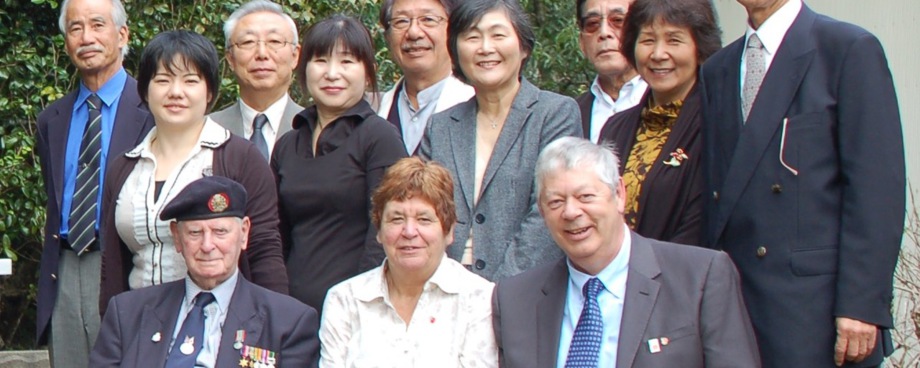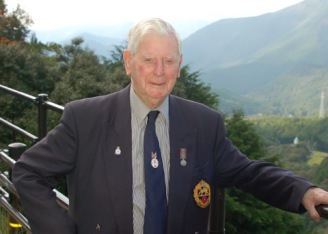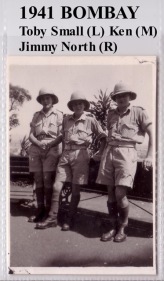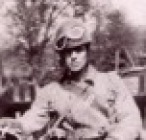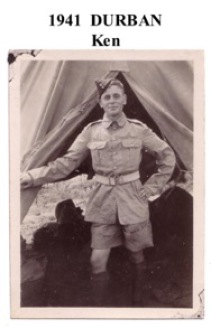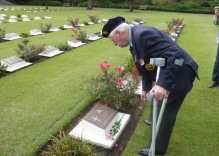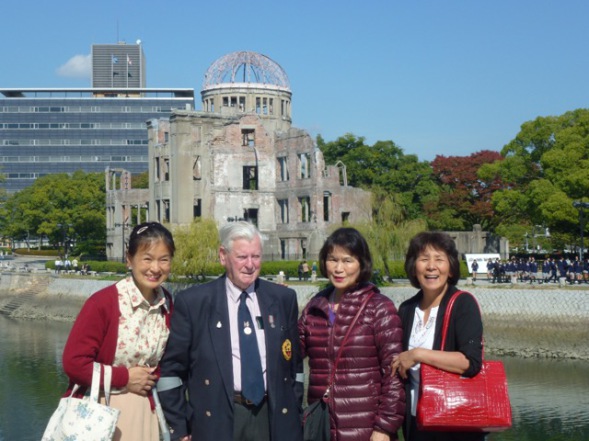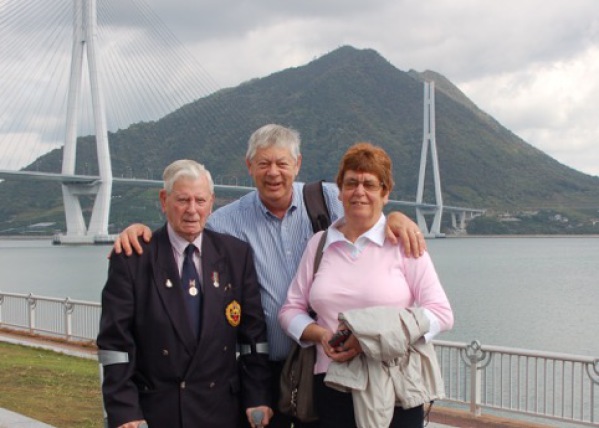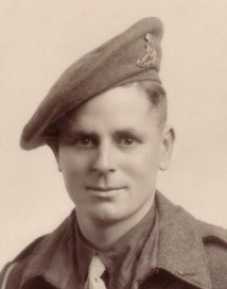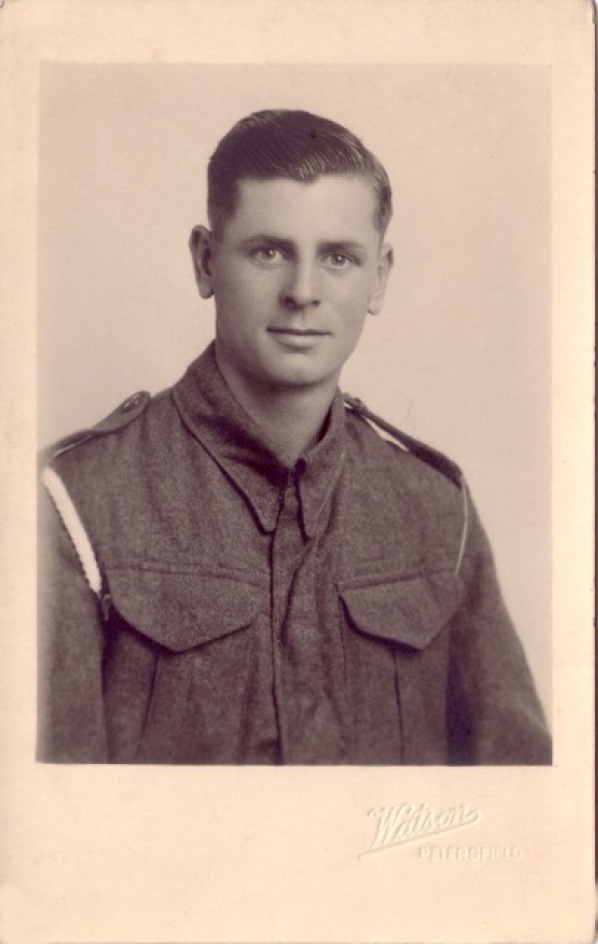by Mike Heather, son-in-Law of
Ken Pett, the Taiwan PEPOW
Ken Pett joined the British Territorial Army (reservists) in 1938 as an 18 year old. This was the 6th Hampshire Regiment. At the outbreak of WWII (Sept. 1939), the War Dept. converted all the men of the 6th Hampshire’s into two Royal Artillery Anti Tank Regiments (59th and 69th) and he was involved in coastal home defences, with the threat of a German invasion.
In 1941, he was transferred to the 80th Anti Tank Regiment and sailed from Scotland in August 1941, on board the RMS Sythia. He was 21 years old. His journey took him south to Sierra Leone, and then onto Durban in South Africa, before transferring to the SS Johan de Witt, for onward sailing to Bombay in India. In November 1941 the ship eventually reached Singapore where they were meant to be part of a peacekeeping force of the area. (War was not yet declared in Asia).
They were immediately sent up into Malaya. From this point they forged a close association with the 155th Field Regiment (Lanarkshire Yeomanry), which was to last for the next few years, both in battle and also as POWs.
On December 8th, one hour before the attack on Pearl Harbour, the Japanese started landing at Singora (Thailand), Patani (Thailand), and Kota Bharu (Malaya).
The Japanese controlled the skies, and their troops were jungle trained, and the allies were in constant retreat southwards. Many brave battles ensued, but the Japanese always overcame lines of defence.
Eventually every allied troop had been forced back onto the island of Singapore, and the local population was dying in large numbers by the superiority of the Japanese bombers. Eventually the Japanese troops crossed the causeway onto Singapore Island, and were fighting towards Singapore City where they got control of the reservoirs, the only source of fresh water for the population.
The allies had no choice but to surrender on February 15th 1942, to prevent the mass annihilation of the civilian population.
As soon as the men were interned in prison camps, the brutality commenced. Camp conditions were horrific and there was a dramatic shortage of food. Rice was the basic food. It disagreed with the men’s digestive system, and dysentery was rife.
Ken was soon sent to Thailand where he was involved in the building of the base camp on the Burma/Siam ‘railway of death’, made famous in the film “Bridge over the River Kwai”. He caught malaria at this camp and was returned to Singapore.
In late October 1942, he was herded onto an old cattle ship, named England Maru, with 1100 fellow men. They were locked down into the stinking holds of the ship, and two weeks later, in a terrible condition, arrived at the port of Keelung in Formosa (nowadays called Taiwan).
The men were then forced to march (many could only crawl), to their new POW Camp. This was called Kinkaseki. Sited in the hills of northern Formosa, this was a very wet area usually with rain clouds below them. They were always wet and cold. The men were forced to slave in the neighbouring copper mine from dawn to dusk, working in very dangerous conditions. They were given quotas of how much copper ore they had to mine each day, quotas which were never achievable by men in such poor health and suffering starvation.
Each night approx. 10% of the men would be chosen at random, lined up against the wall of the mine and beaten with the long-handled hammers used in the mine. This daily routine continued for two and a half years, hundreds died through sickness, starvation, or injury, but they were always replaced by men from other camps. Lives were cheap to replace.
By May 1945, the Japanese decided to close the mine, because every shipload of copper being sent to Japan was being sunk. The commander of Asian POW Camps issued the order that all POWs were to be murdered by gas, poison or burning, if the Americans landed.
The men from Kinkaseki were marched into the jungle and eventually reached an area called Kukutsu. As there was no camp there, the men had to cut down large bamboos to make a clearing, and attempt to build some shelters. Every day a small contingent of men had to walk about ten miles to a village for food for themselves and the Japanese guards. On one of these trips, Ken collapsed at the trackside, his level of endurance had been reached. Apart from lying on a sick bed, Ken remembers very little from this point onward. Luckily he has been able to supply some scarce detail enabling me to trace the rest of his story.
After the dropping of the atom bombs on August 6th 1945 and August 9th 1945, and the eventual surrender of Japan on August 14th 1945, the men received airdrops of food for approximately two weeks.
Towards the end of August the men were led, carried or stretchered, towards the city of Taipei, and into a transit camp where a small advance troop of US marines cared for them. Ken’s weight was just 66 pounds at this point (4 stone 10 pounds …. or 30 Kilograms).
On September 5th 1945, the USS Kretchmer and USS Thomas J Gary (destroyers) made their way into the harbour through the minefields. The first of the men were taken by train to the dockside and taken off “Devils Island” by these two ships and transferred to two aircraft carriers, USS Block Island and USS Santee, which had been waiting offshore. The following day two more destroyers, USS Finch and USS Brister, helped with the evacuation and by midday September 6th, all the men were safely aboard and the six ships sailed for Manila in the Philippines, where they arrived on September 9th.
On arrival in Manila, Ken collapsed once again. He was put into the 248th General Hospital where he stayed for over three weeks, gradually getting his weight back to 98 pounds.
On October 6th 1945, Ken was put on the Hospital Ship USS Tryon bound for San Francisco via Hawaii. When it arrived at Frisco on October 25th, he was sent to Letterman Hospital. On November 2nd 1945, Ken left on a hospital train for New York, where he arrived on November 7th and was taken to the Williamsbridge Hospital near Bronxville, New York. Ken had the pleasure of being shown around New York each day by Miss Emily Stewart. They visited the Empire State Building and also did some ice skating. (In December 2011, the story of Emily was traced, and her grandchildren now have this story and a photograph of them together)
On November 13th 1945, Ken sailed home on the RMS Queen Mary arriving in Southampton November 18th 1945.
Ken had been away from home for over 4 years. He is able to forgive, but never to forget.
In 2009, at 89, Ken decided to return to Singapore and Formosa. A 16,000 mile round trip took in the sights of Singapore he fought at, and the remains of his two POW camps on Formosa. The trip concluded with a stop in Hong Kong where those who had died in the camps on Formosa, were reburied after the war.
In November 2011, Ken returned to Formosa for the opening ceremony of a beautiful wall of remembrance that has been erected at Kinkaseki POW Camp, now a Peace Park. All 4,300 POWs who were interned in Formosa have their names engraved on this memorial wall, not just those who failed to return.
In October 2012, Ken, his daughter Lynn, and son-in-law Mike were invited to join a trip to Japan. This was with Agape, and under the hospitality of Keiko Holmes. At long last he encountered many kind and generous Japanese, and witnessed a beautiful country. The trip encompassed amazing scenery, wonderful culture, and overwhelming hospitality. The family smile when we recall that Ken ate rice for the first time in 67 years, something he had always stated he would never do again.
A trip to Hiroshima left the family with very mixed feelings, as the horrors and sadness of the atomic bomb were so apparent. It still remains that had the bomb not been dropped, most of the POWs would have died through extermination, starvation or disease within months. Although the death toll was horrific, it was a reduction in those who had already died from the blanket bombings that preceded it, and the expected losses on both sides should a ground attack ever have materialised. Let us pray that the decision never has to be made again!
A visit to Yokohama Cemetery was of particular significance to Ken, as we were able to locate the graves of men who had been in the Kinkaseki Camp on Taiwan, before being sent to Nippon as POWs, and had died in captivity before the war ended. A single flower and cross were laid by Ken on each grave.
At the age of 92, and 67 years after the ending of his near-death experiences, it will hopefully help to prevent his recurring nightmares, and truly bring peace to his memories.
In November 2015, at the age of 95, Ken once more had a desire to return to Taiwan, and was greeted by many people he had met on previous trips who were amazed that he was still able to endure such a long journey. The island that Ken had christened “Devil’s Island” during the war, has now become a place full of friendly faces and pleasant memories.
Ken is still proud to tell us that he is the only one of our family who has circumnavigated the world!!
April 2017. Ken has just celebrated his 97th birthday. He lives by himself and fully looks after his bungalow and garden. Although he has now given up driving, he uses his mobility scooter to get into town to do his shopping, and is well known throughout the town.
He regularly goes away for a week or long weekend to holiday camps at Hayling Island or the Isle of Wight, where he enjoys dancing until late and is said to put the ‘youngsters’ (e.g. 70 and 80 year olds) to shame with his energy.
Sadly, Ken passed away at the age of 99, and his funeral was held on 29 April at St Peters Church in Petersfield. May his memory be a blessing to the family and us all.
